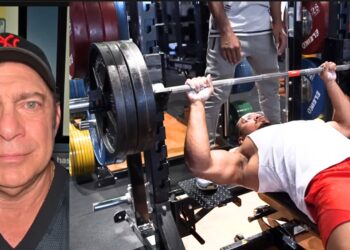Traditional strength training workouts involve prescribing specific weights, sets, and reps. A set of repetitions is separated from the next set by a rest period which can vary from 20-30 seconds to 3 to 5 minutes.
For example, an exerciser may perform three sets of ten reps, five sets of five reps, or even 12 sets of 1 rep, depending on their workout goal.
Escalating Density Training, or EDT for short, does away with this framework and, instead, focuses solely on the amount of work you can perform in a predetermined time.
When using standard set and rep protocols, it’s all too easy to perform the same workout week after week and not see any improvements in performance or appearance.
EDT forces you to work harder from one week to the next, which results in more predictable improvements over time.
The EDT method can be applied to most performance goals, including increasing strength, power, endurance, or muscle size. It’s simply a matter of using the principles of EDT but using an appropriate load and exercises.
Level Up Your Fitness: Join our 💪 strong community in Fitness Volt Newsletter. Get daily inspiration, expert-backed workouts, nutrition tips, the latest in strength sports, and the support you need to reach your goals. Subscribe for free!
How Does EDT Work?
EDT (Escalating Density Training) was first popularized in the mid-’90s by strength coach and elite master powerlifter Charles Staley. Based in Las Vegas, Staley has used his system with Olympic and professional athletes from a range of sports and “regular Joe” exercisers to great effect.
EDT uses pairs of exercises that are performed in a back-to-back style for a predetermined length of time, commonly referred to as Personal Record or PR zones.
For example:
- Pull-up
- Bench press
Or:
- Leg extension
- Leg curl
The length of the PR zone is dependent on your work capacity. Still, it is typically between 10 and 20 minutes, with 15 minutes being ideal for most exercisers and training goals.
Your task during each PR zone is to perform as many repetitions of both exercises as possible. The next time you perform the same EDT workout, you must strive to complete more reps in the same timeframe.
This is accomplished by working more and resting less. The end result, an increase in workout density, provides the stimulus for increased muscular development.
Your weights should reflect your training goal, so:
- Muscular endurance, use your 15-20 repetition maximum
- Hypertrophy (muscle building), use your 10-12 repetition maximum
- Strength, use your 3-5 repetition maximum
Start each PR zone by performing around 50% of the reps you could do in an all-out set to avoid reaching exhaustion too soon. The idea is to try and perform as many reps per PR zone as possible, so pacing is important. Fatigue should accumulate gradually and not peak too soon.
In fact, the first few rounds should feel relatively easy but don’t worry, things will start to get more demanding as the PR zone progresses. Just keep moving back and forth between your paired exercises, resting only when you need to.
With an eye on the clock, make sure you pick up the rep count as your PR zone draws to a close, so you accumulate the highest possible number of reps. The last few reps should be really tough!
At the end, make a note of the number of repetitions you completed, and then try to beat that total next time. When you can beat your first workout rep total by more than 20%, increase your weights by 10-20 pounds and build up all over again.
The Math of EDT
With EDT, your main objective is to do more reps per PR zone from one week to the next. Any increase in reps shows you have worked harder and should, therefore, see some corresponding increases in strength and/or muscle size.
But, if you want a more precise measure of your workout, you can also calculate precisely how much weight you have lifted during each PR zone.
This is by no means essential, but you may be interested to know just how much work you perform during an EDT workout. You can also use this figure to determine how much you have improved from one workout to the next as a percentage.
For example:
Workout 1 – 15-minute PR Zone consisting of bench press and lat pulldowns
- Bench Press: 67 reps with 135lbs = 9045lbs
- Lat pulldowns: 61 reps with 120lbs = 7320lbs
You can now use these figures to measure any increases in actual work performed in subsequent workouts…
Workout 2– one week later using the same load and 15-minute PR Zone
Level Up Your Fitness: Join our 💪 strong community in Fitness Volt Newsletter. Get daily inspiration, expert-backed workouts, nutrition tips, the latest in strength sports, and the support you need to reach your goals. Subscribe for free!
- Bench Press: 72 reps with 135lbs = 9720lbs (an increase of 675lbs or 7.46%)
- Lat pulldowns: 67 with 120lbs = 8040lbs (an increase of 840lbs or 9.83%)
EDT Advantages and Benefits
Not sure if EDT is the right workout for you? Consider these advantages and benefits and then decide!
You know precisely how long your workout will last
EDT workouts usually consist of several PR zones. As such, you should be able to predict how long your workout will take. For example, if you planned to do three 15-minute PR zones and a ten-minute PR zone, you know you should be done in about 55-minutes.
Work paired muscle groups evenly
The best PR zones consist of opposing muscle groups, e.g., back and chest, biceps and triceps, or quads and hamstrings. Using the EDT method means both muscle groups should be trained pretty evenly. This is good for muscle balance which is important for aesthetics and structural integrity.
More time-efficient workouts
Using standard set and rep schemes, most exercisers spend more time resting than they do training, which is not an efficient use of your time.
With EDT, rests are much shorter, so you can get more work done in less time. You should also find that you can do far more reps using EDT than with regular sets and reps, leading to a more intense and voluminous workout.
Good for fat burning
With more time spent exercising and less time spent resting, your caloric expenditure per workout should be higher with EDT than a traditional set and rep workout. This could help you get leaner, faster, and without resorting to cardio.
Get a great pump
Short rests and back-to-back exercises will force a lot of blood into the muscles you’re working on. If you are looking for a great pump, EDT delivers.
Variety
Even the best workout will stop working if you do it often enough. And while there are lots of different ways to organize your training, EDT is probably something you’ve never done before. That’s why it’s such a powerful tool. So, if you are stuck in a training rut, EDT could be just what you need to reignite your progress.
Versatile
EDT is an excellent standalone training method, and we’ve provided you with a workout to follow later in this article. But, you can also use EDT as a standalone finisher after your regular workout.
For example, try doing a ten-minute PR zone of cable curls and triceps pushdowns at the end of your next upper body workout or leg extensions and leg curls after a lower-body workout.
You don’t have to go all EDT, all the time if you don’t want to. Instead, use this method as little or as much as you want.
Downsides
Of course, there are a couple of downsides to consider, too…
Monopolizing two sets of equipment
Doing two exercises back to back for 10 to 20 minutes means no one else will be able to use them during your PR zone. If they do, it could disrupt your entire workout.
As such, EDT may not be practical in a busy gym.
Also, you’ll need to make sure that both sets of equipment are next to each other. For example, you don’t want to waste time walking from one end of the gym to the next, which would severely undermine the effectiveness of this system.
Because of this, EDT may be impractical in some gyms, especially during peak times.
You MUST count your reps
For EDT to work, you must keep track of how many reps you’ve performed and record that number for your next workout. As such, you’ll need to keep a pen and paper with you and write down your score after each and every round. Some exercisers may find this distracting or annoying.
Sample EDT Workout
Escalating Density Training is a simple yet effective training approach. As such, you should have no problem putting your own EDT workouts together. But, to save you the bother, here is an example to try!
Do the following workouts on non-consecutive days, e.g., Monday, Wednesday, and Friday.
But, before you begin, spend a few minutes warming up to prepare your muscles and joints for what you are about to do. For example, being with 5-10 minutes of easy cardio followed by some dynamic mobility and flexibility exercises for the muscle groups and body parts you are about to train.
Remember to count and record the number of reps you perform. Make sure you do your best to beat that number the next time you repeat the workout.
Workout 1 – Upper Body (horizontal push & pull plus arms)
| Exercise | Duration | |
| PR Zone #1 | Incline dumbbell bench press | 15 minutes |
| Cable seated row | ||
| PR Zone #2 | Wide-grip barbell bench press | 15 minutes |
| Inverted rows | ||
| PR Zone #3 | Chest dips | 15 minutes |
| Face pulls | ||
| PR Zone #4 | EZ barbell biceps curls | 15 minutes |
| Triceps cable pushdowns |
Workout 2 – Lower body
| Exercise | Duration | |
| PR Zone #1 | Squats | 20 minutes |
| Standing calf raises | ||
| PR Zone #2 | Leg extensions | 15 minutes |
| Leg curls | ||
| PR Zone #3 | Alternating lunges | 15 minutes |
| Seated calf raise | ||
| PR Zone #3 | Kneeling cable crunches | 10 minutes |
| 45-degree back extensions |
Workout 3 – Upper Body (vertical push & pull plus arms)
| Exercise | Duration | |
| PR Zone #1 | Seated dumbbell shoulder press | 15 minutes |
| Pull-ups/chin-ups | ||
| PR Zone #2 | Push-press | 15 minutes |
| Medium grip lat pulldown | ||
| PR Zone #3 | Cable curls | 10 minutes |
| Rope triceps pushdowns | ||
| PR Zone #4 | Preacher curl | 10 minutes |
| Skull crusher |
Escalating Density Training – Wrapping Up
Escalating density training is a training system just like supersets, drop sets, and trisets. But, unlike those methods, it’s not meant to be just “bolted on” to your existing workout. Instead, EDT can be the entire framework of your workout.
With EDT, your workout becomes much more quantifiable, and it’s easy to see if you’ve trained harder from one week to the next. All you have to do is focus on one thing: pumping out more reps per PR zone.
With shorter rests, you’ll also get more work done in less time, and you can modify EDT for almost any training goal, from bodybuilding to training for pure strength or power.
So, if you are looking for an alternative to the standard sets and reps method of strength training, EDT is a very viable and practical option.










